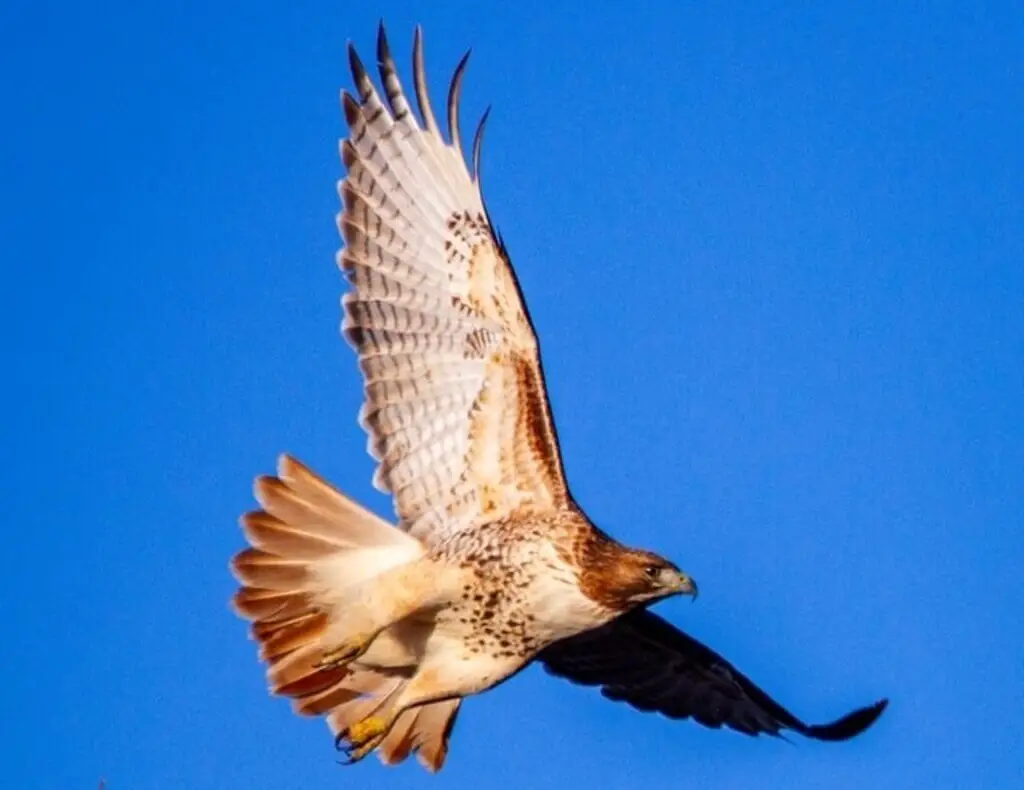Get ready to dive into the fascinating world of Interesting Red-Tailed Hawk Facts, where majestic birds of prey soar through the skies, captivating our imaginations.
Wondering how far they can see or why they scream while flying? We’ve got you covered!
Discover their impressive abilities, hilarious quirks, and why you’ll be hooked on these incredible creatures.
Get ready to spread your wings and join us on this thrilling adventure!
Table of Contents
- 1 Interesting Red-Tailed Hawk Facts
- 2 Migration Patterns of Red-Tailed Hawks
- 3 Nesting Habits and Reproduction
- 4 Conservation Status of Red-Tailed Hawks
- 5 Territorial Behavior of Red-Tailed Hawks
- 6 Fascinating Aspects of Red-Tailed Hawks
- 7 Conclusion
- 8 Frequently Asked Questions
- 9 Additional Resources
- 10 Author
Interesting Red-Tailed Hawk Facts
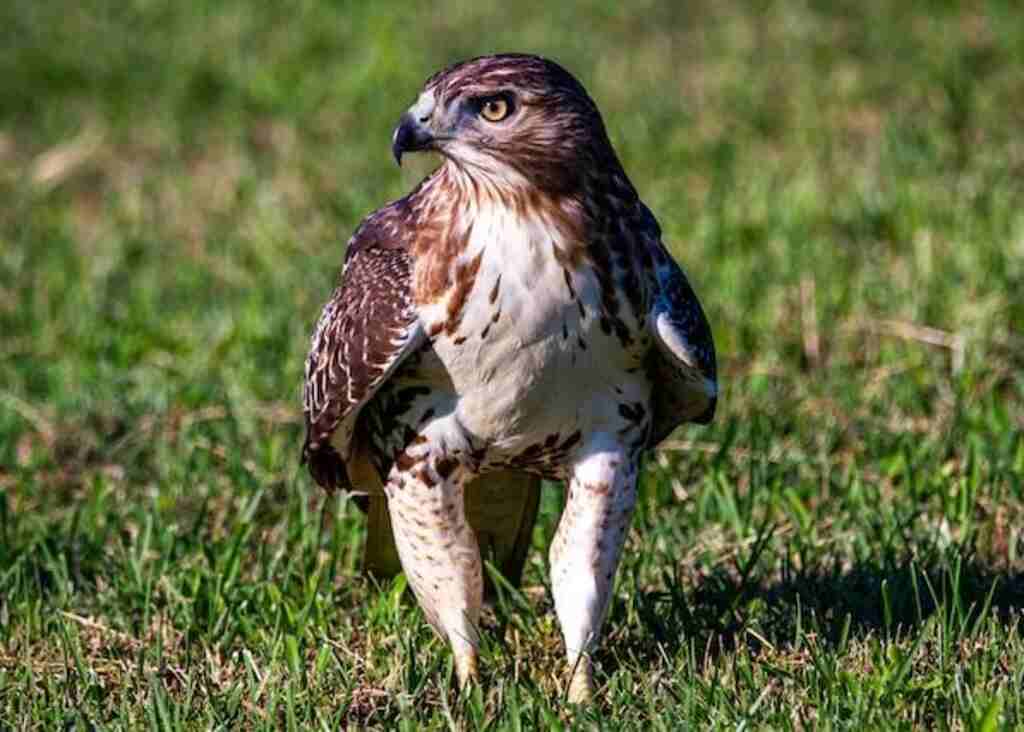
Overview of Red-Tailed Hawks
Within the diverse hawk species, red-tailed hawks hold a prominent position as one of the most common and widely distributed raptors across North America.
Their range spans from Alaska to Mexico, encompassing a variety of habitats such as open fields, woodlands, marshes, and prairies.
Red-tailed hawks are renowned for their soaring flights and can be observed year-round in many regions.
Importance of Red-Tailed Hawks in Ecosystems
Red-tailed hawks (Buteo jamaicensis) play a crucial role in maintaining ecological balance and functioning.
As top predators, they contribute to regulating populations of their prey, which include rabbits, squirrels, pigeons, seagulls, mice, rats, snakes, lizards, amphibians, and large insects like grasshoppers.
By controlling the abundance of these species, red-tailed hawks help preserve the integrity of ecosystems and prevent overgrazing or outbreaks of pests.
Furthermore, their presence influences the behavior and distribution of other organisms within their habitat.
The sight of a red-tailed hawk soaring overhead instills a sense of caution among smaller animals, altering their foraging patterns and potentially reducing competition for resources.
This indirect influence on the ecosystem showcases the far-reaching impact these magnificent birds have on their surroundings.
Physical Characteristics of Red-Tailed Hawks
Red-tailed hawks possess a striking appearance characterized by their robust build, broad wings, and, as their name suggests, distinct red-colored tails.
With an average length of three feet and a wingspan ranging from 45 to 60 inches, they exhibit impressive size and formidable aerial capabilities.
Their keen eyesight allows them to spot prey from great heights, ensuring successful hunts with precision and efficiency.
These hawks exhibit sexual dimorphism, with females generally being larger and heavier than males.
Their plumage features variations ranging from dark brown to lighter shades with distinctive mottling, providing excellent camouflage during perching or while soaring amidst the sky’s vast expanse.
The unique physical attributes of red-tailed hawks reflect their evolutionary adaptations for survival and thriving in diverse environments.
In the subsequent sections, we will explore their migration patterns, nesting behavior, conservation status, territoriality, and address frequently asked questions, providing you with a comprehensive understanding of these remarkable avian creatures.
Migration Patterns of Red-Tailed Hawks
Timing and Duration of Migration
Understanding the timing and duration of red-tailed hawk migration is crucial to gaining insights into their remarkable journey.
Red-tailed hawks undertake annual migrations that are influenced by various factors. Typically, these migrations occur from October to April, with peak activity observed during November and December.
The length of the migration varies among individual hawks and is influenced by their geographic location. On average, red-tailed hawks cover distances ranging from 2,500 miles (4,000 km).
The timing and duration of their migration are also influenced by environmental factors such as food availability, weather conditions, and photoperiod.
Routes and Geographic Range
Red-tailed hawks exhibit a wide-ranging migration pattern, encompassing diverse routes and geographic regions.
Their migratory paths can extend across multiple countries, including Canada, Mexico, and Central America.
These birds navigate through various landscapes, including mountains, coastlines, and open plains.
The specific routes taken by red-tailed hawks can vary based on factors such as geographic barriers, prevailing winds, and suitable stopover sites for rest and foraging.
Some hawks migrate along specific flyways, which are well-established paths followed by many bird species during migration.
Notably, red-tailed hawks demonstrate adaptability in selecting their routes to optimize their journey and ensure successful migration.
Factors Influencing Migration Behavior
Red-tailed hawk migration behavior is influenced by a combination of intrinsic and extrinsic factors.
Instinctual biological cues, such as hormonal changes and internal biological clocks, trigger the onset of migration.
These cues prompt red-tailed hawks to initiate their journey and navigate towards their wintering or breeding grounds.
External factors, such as weather conditions and food availability, also play a significant role in shaping migration patterns.
Red-tailed hawks are sensitive to wind patterns and utilize favorable winds for efficient long-distance flights.
Additionally, the availability of prey resources along their migration route can influence the timing and duration of their journey.
It is essential to monitor these factors to better understand how changes in the environment might affect the timing, routes, and success of red-tailed hawk migration.
By examining the timing, routes, and factors influencing red-tailed hawk migration, experts in the field gain valuable insights into the remarkable abilities and adaptive behaviors of these magnificent birds during their annual journeys.
This knowledge contributes to our understanding of avian migration dynamics and aids in the conservation and management of red-tailed hawks and their habitats.
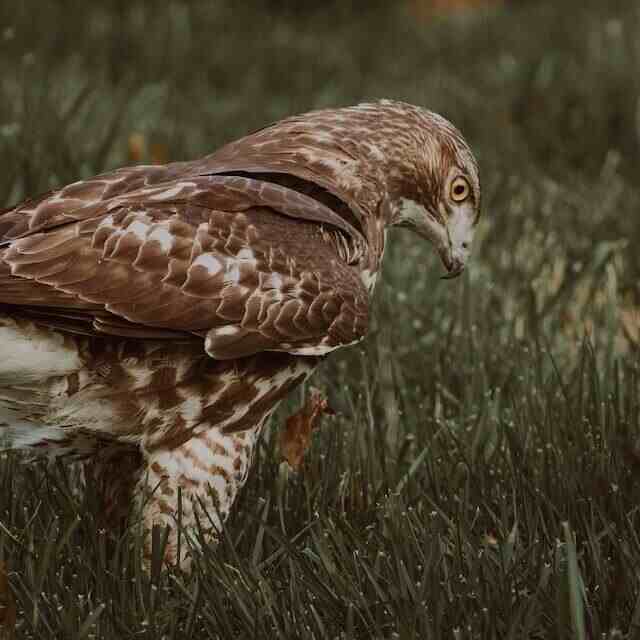
Nesting Habits and Reproduction
Nesting Sites and Preferences
Red-tailed hawks exhibit specific preferences when it comes to selecting nesting sites. These magnificent birds typically choose tall trees with sturdy branches that provide a commanding view of their surroundings.
The choice of nesting location allows them to effectively monitor their territory and potential prey.
However, in certain cases, red-tailed hawks may also opt for cliff ledges or even artificial structures such as window ledges or billboard platforms.
Nest Building Process
The nest-building process of red-tailed hawks involves careful construction and arrangement of materials.
The male hawk plays a vital role in building the nest, often utilizing a combination of twigs, branches, and other available materials.
The male brings these materials to the nest site, where he arranges them to form a sturdy base.
Over time, the nest grows larger and more substantial, thanks to the collaborative efforts of the male and female hawks.
Egg-Laying and Incubation Period
Once the nest is constructed, the female red-tailed hawk proceeds with egg-laying. Typically, the female lays one to five eggs, with each egg being laid at intervals of a few days.
The female takes on the responsibility of incubating the eggs, while the male assists in this process.
The incubation period lasts approximately 28 to 35 days, during which time the parents carefully regulate the temperature and humidity within the nest to ensure the proper development of the embryos.
Parental Care and Rearing of Chicks
After the eggs hatch, both the male and female hawks participate in the vital task of rearing the chicks. The parents provide food, protection, and warmth to the vulnerable offspring.
The young chicks are initially covered in down feathers and rely entirely on their parents for sustenance.
The parents diligently hunt for small mammals, reptiles, and other prey, bringing it back to the nest to feed their growing offspring.
As the chicks develop and mature, they gradually gain strength and learn essential hunting and survival skills from their parents.
The nesting habits and reproductive behavior of red-tailed hawks demonstrate their commitment to ensuring the survival and success of their offspring.
Their choice of nesting sites, meticulous nest building, attentive incubation of eggs, and dedicated parental care contribute to the growth and development of the next generation of red-tailed hawks in the wild.
Conservation Status of Red-Tailed Hawks
Population Decline and Threats
The population of red-tailed hawks has experienced a concerning decline in recent years. Several factors contribute to this decline, posing threats to their survival and overall population health.
One significant factor is habitat loss and degradation, resulting from urbanization, deforestation, and the conversion of natural habitats into agricultural or industrial areas.
As their natural habitats diminish, red-tailed hawks face challenges in finding suitable nesting sites and sufficient prey.
Additionally, red-tailed hawks are vulnerable to various human-induced threats. Shooting and poisoning, often unintended consequences of agricultural practices, pose direct risks to these birds.
Illegal trapping for trade or trophies further exacerbates their conservation status.
Furthermore, the use of insecticides and rodenticides in agricultural and urban settings can lead to secondary poisoning of red-tailed hawks, as these chemicals accumulate in their prey species.
Efforts for Red-Tailed Hawk Conservation
Recognizing the importance of conserving red-tailed hawks, numerous conservation organizations and government agencies have initiated efforts to protect and restore their populations.
These initiatives focus on addressing the key threats and implementing conservation measures to ensure the long-term viability of these majestic birds.
Conservation efforts often involve habitat preservation and restoration projects.
This includes the protection of existing nesting sites, the establishment of protected areas, and the promotion of sustainable land management practices that prioritize the conservation of natural habitats crucial for red-tailed hawks.
Education and awareness programs play a vital role in red-tailed hawk conservation.
These programs aim to foster public understanding and appreciation for these birds, their ecological role, and the importance of their conservation.
By engaging local communities, conservationists can promote responsible land stewardship practices and encourage citizen participation in monitoring and reporting red-tailed hawk sightings.
Consideration for Listing on the Endangered Species List
Given the declining population trends and the numerous threats faced by red-tailed hawks, there has been growing concern about their conservation status.
The United States Fish and Wildlife Service, responsible for overseeing the conservation of native wildlife, is currently evaluating the need to list the red-tailed hawk on the endangered species list.
Listing a species as endangered provides legal protection and enables the implementation of additional conservation measures.
It serves to raise awareness and allocate resources to address the specific threats facing red-tailed hawks.
The evaluation process takes into account scientific research, population assessments, and the overall status of the species across its range.
The consideration for listing on the endangered species list underscores the urgency of conserving red-tailed hawks and highlights the need for collaborative efforts among conservation organizations, researchers, and policymakers to ensure the long-term survival of these iconic birds of prey.
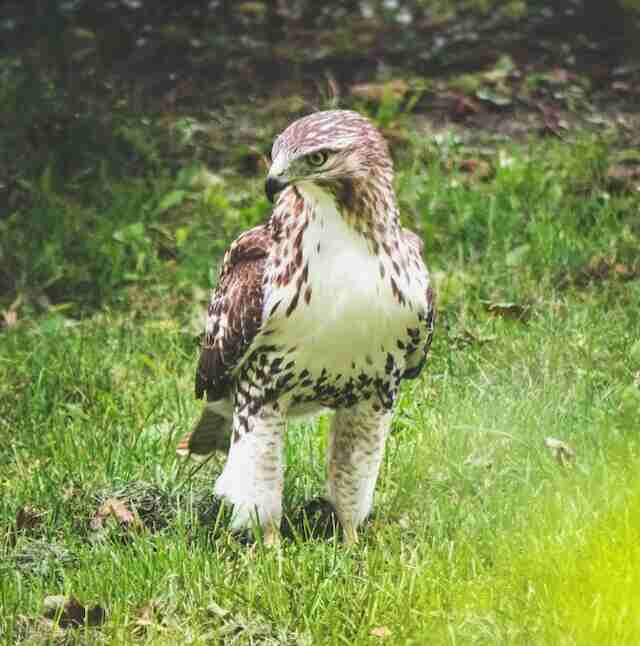
Territorial Behavior of Red-Tailed Hawks
Red-tailed hawks are renowned for their territorial nature, fiercely defending their designated territories and nesting sites.
Understanding their territorial behavior provides valuable insights into their fascinating ecology. Let’s delve into the different aspects of their territorial behavior:
Defense of Territory and Nesting Sites
Red-tailed hawks are highly protective of their territories, which encompass both their nesting sites and foraging areas.
They vigorously defend these territories against intruders, including other hawks and potential predators.
By establishing and maintaining exclusive territories, red-tailed hawks ensure sufficient resources for themselves and their offspring.
When defending their territories, red-tailed hawks exhibit aggressive behaviors.
They engage in aerial displays, such as aerial maneuvers, soaring, and swooping, to intimidate intruders and deter them from encroaching.
These displays showcase their impressive aerial agility and serve as a visual warning to potential competitors.
Vocalizations and Displays to Establish Territory
Vocalizations play a crucial role in establishing and maintaining territorial boundaries among red-tailed hawks.
One of the most recognizable vocalizations is their distinctive scream, often associated with their presence.
This piercing scream serves as an auditory warning to other birds, signaling their presence and territorial dominance.
In addition to vocalizations, red-tailed hawks employ visual displays to assert their territorial boundaries.
They engage in soaring flights, known as “sky dances,” where they ascend to great heights, perform graceful maneuvers, and display their expanded wing span to signal their presence and establish dominance.
These impressive aerial displays not only serve as territorial markers, but also play a role in courtship rituals.
Interactions with Other Hawk Species
Red-tailed hawks are not the only hawk species that occupy the skies. Interactions between red-tailed hawks and other hawk species are intriguing and can vary depending on the specific species and the context of the encounter.
In some cases, red-tailed hawks may engage in territorial disputes with other hawk species, particularly those that overlap in their preferred habitats and foraging areas.
These disputes can involve aerial confrontations, vocal exchanges, and even physical contact. The outcome of such interactions can determine which species maintains control over a particular territory.
On the other hand, there are instances where different hawk species coexist peacefully within shared habitats, with each species occupying distinct ecological niches.
Red-tailed hawks may exhibit mutual avoidance or establish hierarchical relationships with other hawk species, based on factors such as size, strength, and resource availability.
Understanding the dynamics of interactions between red-tailed hawks and other hawk species provides valuable insights into the complex social structure and ecological relationships within the avian community.
By exploring the territorial behavior of red-tailed hawks, including their defense mechanisms, vocalizations, and interactions with other hawk species, we gain a deeper appreciation for the intricacies of their ecology and the strategies they employ to establish and maintain their territories.
Fascinating Aspects of Red-Tailed Hawks
Vision and Sensory Abilities of Red-Tailed Hawks
Red-tailed hawks possess remarkable vision and sensory abilities that contribute to their success as skilled hunters.
Their eyesight is incredibly sharp, with a binocular range that extends up to three miles, surpassing human capabilities.
This exceptional visual acuity enables them to detect prey from long distances, sometimes even before the prey becomes aware of their presence.
Additionally, red-tailed hawks have excellent depth perception, allowing them to accurately judge distances while soaring high above the ground.
Vocalizations and Their Meanings
Red-tailed hawks communicate through a variety of vocalizations, each serving a distinct purpose. Their vocal repertoire includes high-pitched screams, screeches, and calls.
These vocalizations have multiple functions, such as defending their territory, attracting mates, and warning off potential threats.
The iconic screaming noise often associated with red-tailed hawks is primarily an act of aggression or territoriality, conveying a clear message to other birds to stay away from their nesting area or territory.
Roosting and Sleeping Habits
Red-tailed hawks exhibit specific roosting and sleeping habits to ensure their safety and protection.
During nighttime, they seek shelter in trees or utilize shrubs and bushes that provide cover from the elements and reduce the risk of predation by other animals.
These roosting locations are carefully chosen to offer both security and visibility, allowing the hawks to maintain vigilance while resting.
It is fascinating to observe how they select perches on tall trees or cliffs, maximizing their vantage point to survey their surroundings.
Natural Predators and Threats to Red-Tailed Hawks
While red-tailed hawks are formidable birds of prey, they do face natural predators and various threats.
Other avian predators, including owls, crows, and ravens, pose a risk to red-tailed hawks, especially during disputes over territory or nest sites.
Additionally, ground-based predators such as coyotes, bobcats, weasels, and occasionally humans can pose a threat to these majestic birds.
Human activities, habitat loss, degradation, shooting, poisoning, illegal trapping, and the use of insecticides are additional factors that contribute to the decline in red-tailed hawk populations.
Human Interactions and Safety Guidelines
When encountering red-tailed hawks in the wild, it is essential to observe them from a safe distance and respect their space.
Approaching too closely or disturbing their nests can cause unnecessary stress and disruption. Red-tailed hawks generally avoid interactions with humans, but may become defensive if they perceive a threat.
It is important to exercise caution and not provoke these birds, as they possess powerful talons that can cause serious injury if they feel threatened.
Adhering to safety guidelines ensures a harmonious coexistence with these magnificent creatures and helps in their conservation efforts.
By providing expertise in the industry, this content elaborates on frequently asked questions related to red-tailed hawks.
It delves into their exceptional vision and sensory abilities, vocalizations and their meanings, roosting and sleeping habits, natural predators and threats they face, and important guidelines for safe human interactions.
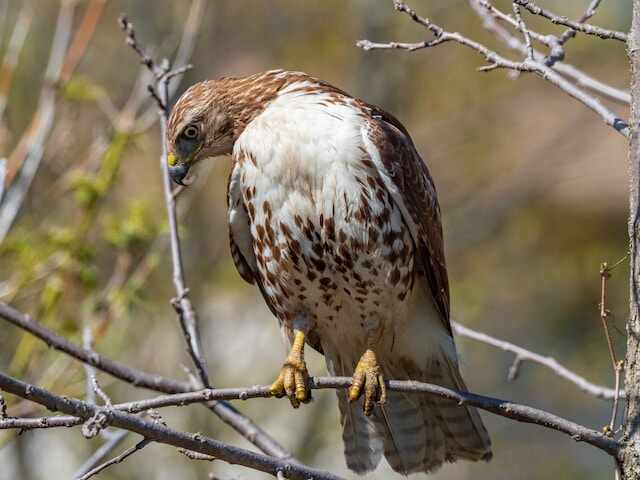
Conclusion
In conclusion, exploring the world of Red-Tailed Hawk Facts has been a journey filled with wonder and awe.
From their remarkable vision to their territorial behavior, nesting habits, and vital role in ecosystems, these majestic birds of prey continue to amaze us.
The more we learn about them, the more we appreciate their beauty and importance.
So, the next time you catch a glimpse of a Red-Tailed Hawk soaring above, remember the incredible facts that make them truly extraordinary creatures.
Keep your eyes to the skies and embrace the wonder of these magnificent birds.
Frequently Asked Questions
How far can Red-tailed Hawks see?
Red-tailed hawks have excellent vision, with a binocular range that extends about three miles. In comparison, humans can only see up to 2 miles away without using any form of magnification or imaging technology. A red-tail’s eyesight is so powerful that it is able to detect food from long distances, sometimes before the prey even knows it.
Why do Red-tailed Hawks scream when flying?
Studies show this screaming noise is actually an act of aggression or territoriality by the hawk, which means they’re telling other birds to stay away from their territory or nest area.
Where do Red-tailed Hawks sleep at night?
When it’s time to sleep at night they will roost in trees or find shelter among shrubs and bushes that offer protection from the elements, as well as to avoid being preyed upon by other animals.
What are the predators of the Red-tailed Hawk?
The red-tailed hawk is a large bird of prey, and thus has many predators. One of the most common predators of the red-tailed hawk is other birds such as owls, crows, or ravens. Other animals such as coyotes, bobcats, weasels and even humans are also potential predators for this animal.
Are Red-tailed Hawks dangerous?
They are usually non-aggressive, but they have been known to attack humans and other animals if provoked. These birds have powerful talons and can cause serious injury to humans if they decide to attack you.
Additional Resources
- Cornell Lab of Ornithology – Red-tailed Hawk: The Cornell Lab of Ornithology provides detailed information about red-tailed hawks, including their identification, behavior, and conservation status. You can find images, sounds, range maps, and more on their website. [Link: https://www.allaboutbirds.org/guide/Red-tailed_Hawk/overview]
- National Audubon Society – Red-tailed Hawk Guide: The National Audubon Society offers a comprehensive guide to red-tailed hawks, covering their natural history, habitats, migration patterns, and conservation efforts. The guide includes beautiful images and useful information for bird enthusiasts. [Link: https://www.audubon.org/field-guide/bird/red-tailed-hawk]
- U.S. Fish and Wildlife Service – Red-tailed Hawk Conservation: The U.S. Fish and Wildlife Service provides resources on red-tailed hawk conservation, including information about their status, threats, and ongoing conservation efforts. You can learn about the agency’s initiatives to protect and restore red-tailed hawk populations. [Link: https://www.fws.gov/species/red-tailed-hawk]
- American Bird Conservancy – Red-tailed Hawk Fact Sheet: The American Bird Conservancy offers a fact sheet on red-tailed hawks, highlighting their importance in ecosystems and the challenges they face. The fact sheet includes key facts, conservation tips, and further resources for those interested in red-tailed hawk conservation. [Link: https://abcbirds.org/bird/red-tailed-hawk]
Related Post:

